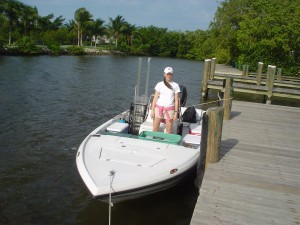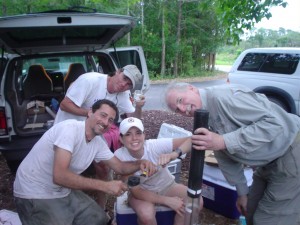Naples Bay Past and Present: A Chronology of Disturbance to an Estuary
Funded by: South Florida Water Management District & The Conservancy of Southwest Florida (Drs. Ceilley, Schmid, Worley, Brenner, Jaeger)
Introduction: Naples Bay, FL is typical of many areas along the coast of Florida where dredge and fill operations have occurred and these actions have destroyed or degraded the estuarine habitats. In the last 50 years, the Bay has experienced an explosion of growth and development along most of its shoreline, thus impacting the fringing mangrove community. Previous studies have indicated that hydrologic factors have also contributed to the decline of this system: 1) freshwater and urban runoff that flows into the Bay has increased, 2) flow and flushing is impeded by dead end canal systems, and 3) inadequate tidal mixing occurs, particularly during the summer. These factors have resulted in slight to moderate eutrophication of the Bay system that is of special concern to the City of Naples, Rookery Bay National Estuarine Research Reserve, and the many residents living along the shoreline. In order to understand the alterations and the response of the system over time, it is necessary to reconstruct the pre-development ecological and biogeochemical conditions of the estuary and the timing and extent of alteration of these conditions. Comparison of past versus present conditions will help to guide restoration efforts and development plans around Naples Bay. This study aims to establish an approach for the reconstruction of recent environmental change in Naples Bay using biogeochemical information, aiding further research into ultimate causes of, and therefore solution to, problems such as nutrient enrichment and hydrologic alteration within the estuary.
 |
 |
Methods: At least three sites will be chosen for sediment coring. The physical parameters of wet and dry mass and density will be determined for each sample. In addition to organic carbon, total nitrogen, and total phosphorous, other chemical analyses that have been used for environmental reconstructions will be performed, including biogenic silica, total lipid and lipid biomarker compounds, stable carbon and nitrogen isotopes, and compound specific lipid biomarkers. These tools have the ability to identify the response by various members of the benthic and planktonic community (bacteria, phytoplankton, macrophytes, etc) to chemical and hydrological stressors as they occurred. For a reliable time frame, however, must be grounded in accurate sediment accumulation rates and horizon dating. 210Pb, 137Cs, total Pb concentrations and x-radiographs will be useful for establishing sediment chronologies. Sediment horizons will also be surveyed for shell biomarkers to further delineate salinity ranges associated with the constituents listed above. For example, dramatic historical shifts in freshwater deliveries to the estuary should be expressed by changes in shell fragments within a given layer.